Why Your Acne Won’t Go Away And What To Do For Fast Relief

While the effects of acne can range from person to person, it’s safe to say that anyone who’s glanced in the mirror and noticed new pimples pushing in has felt the same sinking feeling.
In addition to the whiteheads, blackheads or red bumps themselves, people experience subsequent scabbing or crusting of the swollen sites, as well as redness and scarring.
It’s understandable that you want to feel confident in the face or body that you present to others, and acne (along with everything that goes with it) can make that challenging at times. Acne can lead to antisocial behavior and diminished self-esteem due to concerns over physical appearance.
Let’s learn more about the triggers and root causes behind the development of acne, as well as natural solutions to help alleviate the matter in a hurry.

What Exactly is Acne?
While acne is commonly visualized as unsightly bumps on your face or body, the mechanism of action behind it is often overlooked.
Acne is produced when hair follicles become congested and/or infected resulting in blackheads, whiteheads or red bumps. This condition affects an estimated 50 million people each year and ranges from a few pimples to severe cystic forms.19
Approximately 95% of the population will experience some form of acne during their lifetime.19
For most acne sufferers, peak incidence occurs during the hormone-filled teen years in both sexes, however the incidence is estimated at 50% in adult women and even higher among pregnant women.18,19
Acne is often regarded as a surface skin condition, however the paradigm is shifting to reflect that the root causes of acne are complex and always involve inflammation at its foundation.
No matter what the cause is, it’s important to acknowledge the significant emotional toll acne takes on a person. Up to 50% of adolescents with acne experience disturbances to their psyche, including issues with body image, anxiety, depression, poor self-esteem, social impairment, and thoughts of suicide; this statistic is likely underestimated due to lack of reporting and treatment.19

How Does Acne Occur?
Acne occurrence comes down to one of two processes – either excess keratin or excess sebum production.
Keratin is a protein that holds skin cells together. In “normal” skin, when the cells die they simply separate and are pushed out of the pore.
According to Paul Jaminet, excess keratin, which is common among acne-sufferers, causes skin cells to stick together and makes it harder for them to be shed. This results in a plugging of the hair follicle.1
Sebum is a naturally-occurring oil that skin follicles produce to keep the face moisturized. A pore becomes clogged when sebum gets trapped in it, resulting in what is known as a blackhead. We call it a blackhead because when exposed to air, this trapped sebum oxidizes, giving it its black appearance.
Conversely, whiteheads occur when the pore is closed over by skin, and bacteria invades the follicle. This yields that ever-so-unsightly white, pus-filled look. Jaminet references studies that highlight acne-sufferers’ tendency to produce more sebum than those with “normal” skin, thereby compounding the problem.1
The build-up then causes a reduction in oxygen within the pore. This is a perfect environment for the bacteria P. Acnes to thrive in, causing the immune system’s inflammatory response that you see at the site of the pimple.

Types of Acne
Most cases of acne will fall under the heading of Acne Vulgaris, but there are different types of pimples that may occur. Here are several common forms:
Acne Vulgaris: The most common type of acne. It can appear anytime from early adolescence through well into adulthood. It’s classified as a mild appearance of whiteheads and blackheads.
Papules: These are comedones (plugged hair follicles) that have become irritated; small red or pink bumps may appear and can be very sensitive.
Pustules: These are also comedones that have become irritated but may appear as a whitehead with a red ring formed around them.
Nodules: These are large, irritated bumps that have formed beneath the skin.

Cystic Acne: Similar to a boil, these are large, irritated bumps that have formed beneath the skin, but have also filled with pus. This is considered to be a more severe form of acne.
Acne Conglobata: Often leaving scars, this is one of the more severe and painful forms of acne. This type of acne is characterized by inflamed nodules that are connected to each other under the skin and usually affects the neck, chest, arms and butt.
Acne Mechanica: This form of acne is brought on by heat, sweating and friction. It often appears in areas where tight-fitting clothing or sporting equipment such as a ball cap, helmet or sports bra is worn.

Rosacea is important to mention as it was previously referred to as “acne rosacea”, in reference to the papulopustular subtype which looks very similar to acne.
More recently the two are recognized as separate and distinct conditions even though the underlying causal mechanisms can be similar. Those include Leaky Gut, low stomach acid and SIBO (small intestinal bacterial overgrowth), according to Chris Kresser.20
If you are unsure whether you have acne or rosacea, here are a few guidelines to help you figure it out:
- Rosacea commonly has a central facial location on the middle forehead, nose, cheeks and chin, while acne can be all over the face, neck and shoulders.
- Rosacea has a red, bumpy, swollen, sometimes bloodshot appearance, while acne has a variety of lesions varying from blackheads, pimples, cysts or nodules.
- Treating rosacea is very similar to treating acne in that you must identify the root cause in order to properly address the issue. The information presented in this slide show is highly applicable to rosacea.
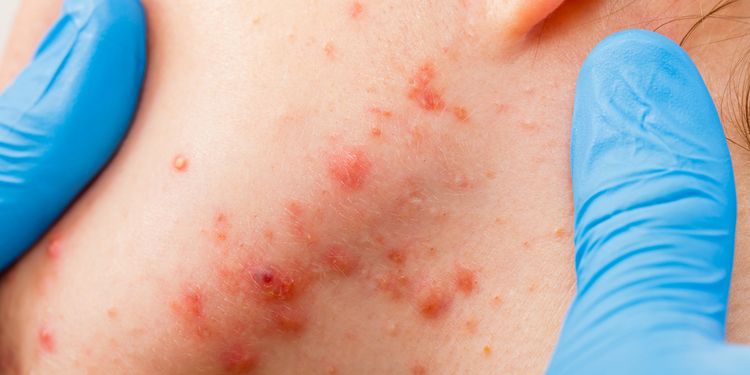
Root Causes of Acne
Acne can have several triggers, including:
Diet can play a major role in the development of acne by altering blood sugar or triggering an inflammatory response from the immune system.
As noted by Dr. Alejandra Carrasco, many of the foods common in the standard American diet, such as dairy, refined sugars, bad fats, and high-glycemic foods that cause a spike in blood sugar, can be a culprit.2
Consuming foods high in inflammatory fats such as conventional meats, as well as fried and processed foods, can also trigger inflammation.
Food sensitivities/allergies of any variety may also contribute to acne, as they activate an immune response that results in inflammation. Some of the most common ones are to gluten, dairy, eggs, nuts, corn and soy. The truth however, is that any food has the potential to act as a trigger for different people.
Additives and colorings in processed foods stimulate the immune system just as food sensitivities do, producing an inflammatory response.
Lack of sleep results in elevated stress hormone levels, which triggers the release of neurotransmitters that can increase the inflammation responsible for acne outbreaks.1
When talking about true root causes however, the following factors top the list:
- Poor GI Health
- Leaky Gut
- Hormonal Imbalances
- Vitamin Deficiency

Root Cause of Acne: Poor GI Health
Intestinal health is often responsible for what shows up on your skin.
When the gut isn’t healthy, proper detoxification and elimination can’t take place.
Toxins then build up within the body and skin, and the problem manifests itself in the form of acne. In individuals with unhealthy GI tracts, the body responds with inflammation in the gut, using up stores of antioxidants in this area rather than in the acne-affected areas. This perpetuates the cycle of inflammation and immune system reactivity, which is what triggers the acne.
Recent studies confirm that inflammation can be a major contributor to the presence of an acne outbreak. According to Paul Jaminet, inflammation is present at the site of an outbreak even before the appearance of the acne-causing bacteria.1
According to Chris Kresser, inflammation, as well as altered GI function in the form of leaky gut, SIBO, and low stomach acid result in increased production of inflammatory substances by gut bacteria, in addition to altered fatty acid and sebum production.20 He further speaks of poor GI function manifesting as “leaky skin” since the skin and gut are both barriers to protect you from foreign invaders.
When this occurs the anti-inflammatory compounds normally produced by the skin are reduced, resulting in increased susceptibility to acne and skin inflammation.20 Further, having an imbalance in gut bacteria or dysbiosis perpetuates the inflammation and leaky gut.

Root Cause of Acne: Leaky Gut
Gut health plays an integral role in systemic health, as well as skin health, and thus leaky gut can be one of the primary causes of acne.
Inflammation from dysbiosis, GI infections, toxins, certain medications, food sensitivities and/or allergies causes the gut to become hyper-permeable, resulting in a loosening of the junctions between the intestinal cells and allowing the gut to become “leaky”.
Substances such as toxins, undigested food particles and pathogens are then able to pass into the bloodstream, creating inflammation throughout the body as the immune system reacts to the foreign molecules.15 The causes of leaky gut must be identified and treated, and the gut must be healed in order for the situation to reverse and the acne to resolve.
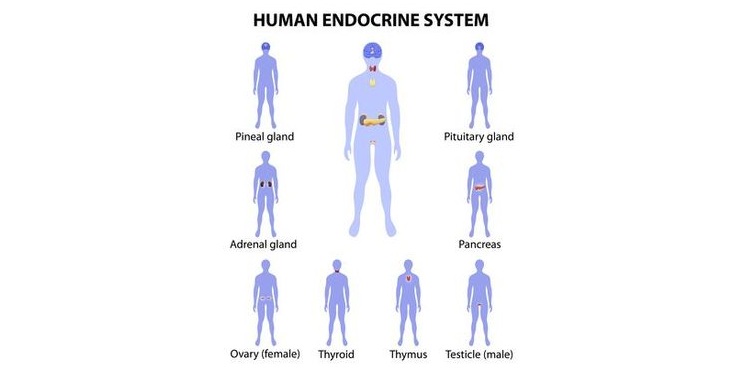
Root Cause of Acne: Hormonal Imbalances
The hormones in our bodies operate in a delicate balance. When this balance is disturbed by stress, poor diet, lack of exercise, inadequate sleep and toxins, inflammation can develop. This process can lead to acne production.
Paul Jaminet notes that elevated levels of certain hormones, such as androgens, insulin, and IGF-1, have been linked to acne.
People with elevated levels of these hormones can have increased levels of sebum and keratin production, resulting in acne.
Insulin is a blood-sugar regulating storage hormone. Consistently elevated blood sugar results in insulin and insulin-like growth factor-1 (IGF-1), which cause surges in testosterone and resulting in increased sebum and keratin production.
Progesterone imbalance can also be an underlying factor contributing to acne. Low progesterone with high estrogen is referred to as estrogen dominance.
High stress levels, high blood sugar and exposure to chemical estrogens found in processed foods, as well as personal care and cleaning products, can result in this type of hormone imbalance.
The use of birth control pills may also contribute to this type of hormone imbalance once you discontinue using it.

Polycystic Ovarian Syndrome (PCOS) is a hormonal condition that plagues many women. It occurs when a woman’s body produces too many androgen hormones, including DHEA, progesterone and testosterone.
One of the most common symptoms of PCOS is acne, along with extra hair growth on the face and body, weight gain, blood sugar dysregulation, infertility and menstrual irregularities. This is a very important root cause that must be addressed as other interventions will not work if the underlying hormone imbalances are not corrected.
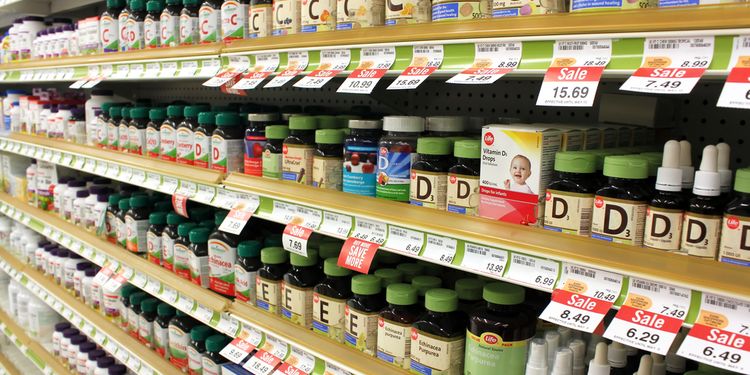
Root Cause of Acne: Vitamin Deficiency
Nutritional deficiencies are one of the common, but less often identified root causes.
Low levels of vitamins A, D, and E, as well as zinc can play a part in the appearance of acne, says Mark Sisson.3
Vitamin A, vitamin E and zinc all have anti-oxidant and anti-inflammatory properties, while zinc and vitamin D modulate the immune system.
Chris Kresser echoes that information, stating that “Another common cause of skin disorders in the modern world is nutrient deficiency. In the industrialized world we are overfed, but undernourished. In fact, more than half of Americans are deficient in zinc, calcium, magnesium, vitamin A and vitamin B6.”11
Essential fatty acid deficiency can also contribute to acne development. In populations where there is high fish consumption, such as amongst Inuits, there is a low incidence of acne due to the anti-inflammatory nature of fish oil.
B vitamin deficiency may result in hormone imbalance and poor detoxification, which can contribute to the development of acne.
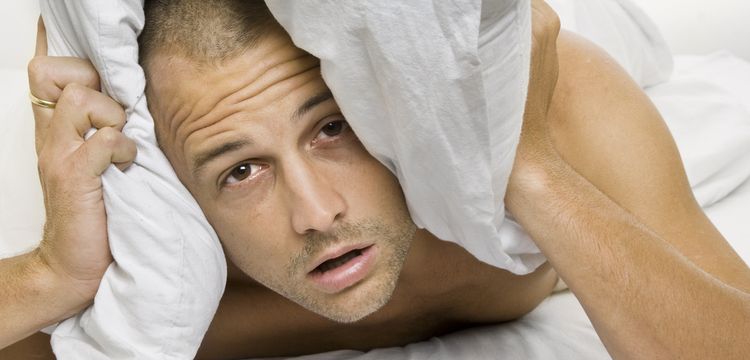
Root Cause of Acne: Stress and Sleep
Life stressors affect all of us. When they spiral out of control, the result is often hormone imbalance, gut dysfunction or poor sleep, which all can lead to acne.
Functional Medicine expert Dr. Amy Myers, M.D. explains, “Stress is your skin’s worst enemy. You know that stress causes hormonal imbalances that negatively affect your complexion.
During sleep, your body is working to repair damaged tissue and soothe inflammation. If you have acne or other skin problems, good, restorative sleep is essential for healing”.12
Elevated stress hormones can drive the androgen hormones testosterone, DHEA and progesterone up, causing acne. Conversely, in adrenal fatigue (where cortisol, the body’s primary anti-inflammatory hormone is low), acne may result from uncontrolled systemic inflammation. In either case, it’s important to rebalance the adrenal hormones.
Dr. Myers further notes, “The natural cycle of your hormones throughout the day is governed by your circadian rhythm, or 24 hour sleep cycle. Insufficient or poor quality sleep raises your cortisol levels much in the same way that stress does. Aim for about 8-9 hours of sleep each night. That’s the amount that most people are going to need, but you can find your ideal number by seeing when you wake naturally without an alarm.”12

Root Cause of Acne: Environmental Toxins
Environmental toxins can wreak havoc on otherwise healthy skin.
Common chemicals such as dioxins, PCBs, phenols, phthalates, benzenes and furans cause a form of acne called Chloracne.4
These chemicals are used industrially, as well as in personal care and cleaning products.
Contaminated food and water are also sources of exposure. Systemic absorption of these chemicals results in blackheads, pustules and cysts on the face and body.4
Acne is listed in the EPA’s chemical database as one of the many harmful side effects of these toxins, among many others.
Because these toxins are attracted to and stored in fat, it makes them difficult to get rid of, leading to other systemic effects such as arthritis, impotence, fatigue, anemia, neuropathy, thyroid dysfunction and liver dysfunction.4 The recovery from this type of acne can take many years, in extremely severe cases.4
Preservatives in personal care and cleaning products, such as parabens and phthalates, are estrogen mimickers that the body views as estrogens and acts accordingly, which may result in acne.

Natural Relief from Acne
There are several topical preparations that have proven to be effective in controlling, and in some cases, reducing acne. Mark Sisson has found success with some of the following:
Manuka Honey: Highly antibacterial, works well for many people when applied directly to the affected area.5
Nicotinamide: The fancy term for topical vitamin B3, which can help to reduce inflammation.5
Willow Bark and Tea Tree Oil: Both are widely recognized for their antibacterial properties, but tea tree oil has the added benefit of acting as an astringent as well.5
Calendula and Feverfew: These can be helpful in reducing redness.5
Natural Masks: Covering the affected areas in solutions consisting of Greek yogurt, turmeric, honey and ginger can provide a calming and soothing effect. Mixing baking soda and water into a paste works for people as well, as does crushing garlic cloves and mixing them with aloe vera gel.
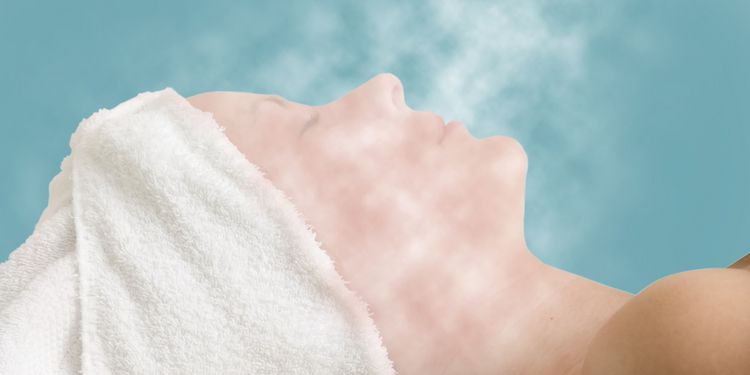
In addition to topical preparations, the following steps can also help decrease inflammation and gently clean the skin:
- Steaming can open pores and increase the absorption of topical treatments.
- Be gentle when cleaning acne-prone areas. Rather than scrubbing with ferocious intensity, use a light exfoliant, such as a simple paste of baking soda or oatmeal mixed with water. If your face is extremely inflamed or sensitive you should avoid any scrubbing or excessive exfoliation.
- Washing the affected area with filtered or distilled water rather than tap water may help.
- Avoid touching your face, change pillowcases often, and clean your smartphone screen.
- Applying a solution of unfiltered apple cider vinegar diluted with filtered or distilled water in a 1:3 ratio twice daily makes a good toner.
- Dr. David Katz of Yale University’s Prevention Research Center explains that exercise helps to reduce acne by increasing blood flow to the skin, as well as regulating hormones.
- Limit your exposure to toxins by using natural products on your body and in your home, as well as eating an organic, non-GMO, whole foods based diet with plenty of purified water.
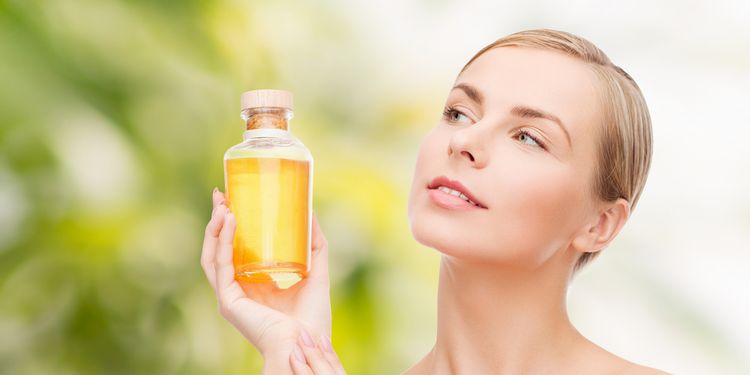
Natural Relief from Acne
Your face has a tendency to produce excess oil when it feels a sense of dehydration, which can be brought on by over-washing and over-exfoliating. For this reason, Dr. Alejandra Carrasco recommends washing your face with oil.
Though this might sound counterintuitive, the antimicrobial properties of many oils, combined with the added benefit of increasing moisture, rather than stripping it away, actually make for an effective cleanser. Dr. Carrasco recommends the following homemade natural cleansing blends:6
Oily Skin: Try a mix of 30% castor oil with 70% sunflower seed oil.
Balanced Skin: Try a mix of 20% castor oil with 80% sunflower seed oil.
Dry skin: Try a mix of 10% castor oil with 90% sunflower seed oil.
- Add the mixture to a clean glass bottle and shake it up.
- Massage a small, but adequate quantity of oil into your face for 45-60 seconds.
- Place a washcloth soaked in warm water over your face until the cloth cools down.
- Use the cloth to wipe off excess oil.
Coconut oil also makes an effective cleanser and moisturizer given its fatty acid profile and antimicrobial properties.
Given the many natural relief options that you’ve got to work with now, you should be well on your way to keeping your acne problem at bay while you address the root causes. Get a more in-depth take on the root causes mentioned earlier by checking out their individually dedicated articles.
